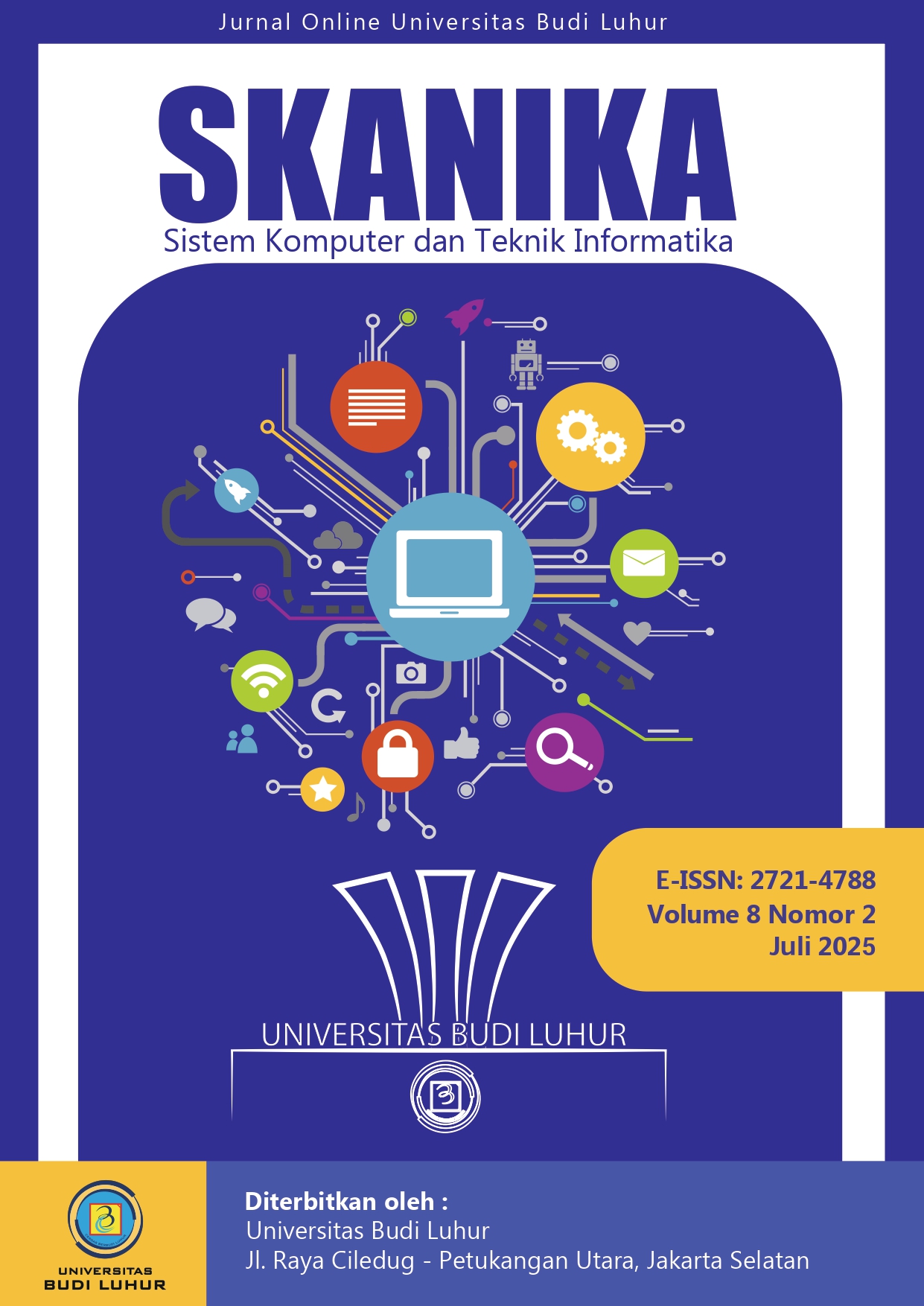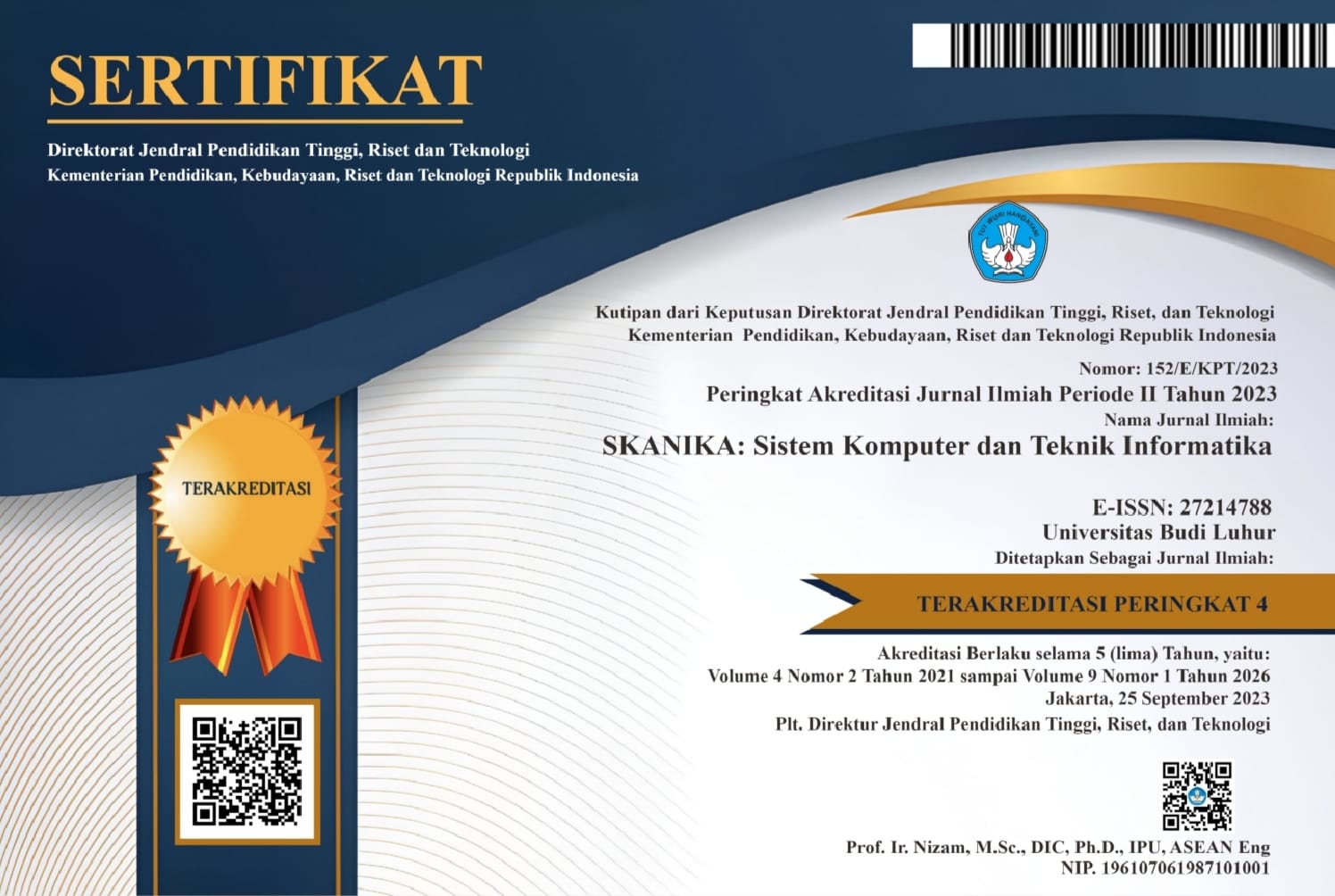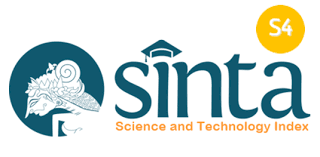PREDIKSI KUNJUNGAN WISATAWAN DI KABUPATEN BANTUL MENGGUNAKAN METODE SEASONAL AUTOREGRESSIVE INTEGRATED MOVING AVERAGE (SARIMA)
DOI:
https://doi.org/10.36080/skanika.v8i2.3583Keywords:
Tourist visit prediction, SARIMA, SARIMA, time series forecasting, web-based system, Bantul Regency Tourism OfficeAbstract
The Bantul Regency Tourism Office faces challenges in collecting tourist attraction data because it is still done manually. This study aims to develop a web-based prediction system using the Seasonal Autoregressive Integrated Moving Average (SARIMA) method. This system is designed to facilitate data collection on tourist attractions while generating predictions of visitor numbers. Based on the results of accuracy testing using MAE (Mean Absolute Error) and MAPE (Mean Absolute Percentage Error), the Parangtritis and Depok Beach tourist areas have MAE values of 35,157.41 and MAPE 22.75%, indicating a fairly large absolute prediction error but still reasonable considering the high volume of visits. Meanwhile, Samas Beach recorded the highest MAPE value of 165.22%, due to data fluctuations that make predictions inaccurate. Conversely, predictions for Goa Cemara Beach, Kwaru Beach, Goa Selarong Area, and Goa Cerme Area have MAPE values below 15%, indicating the model is able to provide fairly good prediction results with a small average error. However, at Pandansimo Beach, the MAPE value reached 46.47%, indicating the model was not yet adequate for this location due to unstable data trends. The results showed that the SARIMA model can be applied to a system to predict tourist visits, but with varying levels of accuracy at each tourist destination, depending on the stability of each tourist destination's data.
Keywords: Tourist visit prediction, SARIMA, time series forecasting, web-based system, Bantul Regency Tourism Office
Downloads
References
[1] “Bupati Bantul Daerah Istimewa Yogyakarta Peraturan Bupati Bantul Nomor 126 Tahun 2016.”
[2] “Jumlah Destinasi Wisata Tahun 2023 - 2025_03-02-2025”, Accessed: Feb. 17, 2025. [Online]. Available: Sumber: https://data.bantulkab.go.id/search/detail?data_id=3.26.0001&ryear=2023%20-%202025
[3] P. Wawancara, A. Pariwisata, E. Kreatif, and A. Muda, “Pedoman Wawancara.”
[4] L. Budianti, M. Yasyfi Avicenna, A. Kusuma Putri, and G. Darmawan, “Pemodelan SARIMA dengan Pendekatan ARCH/GARCH untuk Meramalkan Penjualan Ritel Barang Elektronik,” 2024.
[5] G. Christie, D. Hatidja, and R. Tumilaar, “Penerapan Metode SARIMA dalam Model Intervensi Fungsi Step untuk Memprediksi Jumlah Pegunjung Objek Wisata Londa (Application of the SARIMA Method in the Step Function Intervention to Predict the Number of Visitors at Londa Tourism Object),” JURNAL ILMIAH SAINS, vol. 22, no. 2, pp. 96-103, 2022, doi: 10.35799/jis.v22i2.40961.
[6] B. G. Prianda and E. Widodo, “Perbandingan Metode Seasonal Arima Dan Extreme Learning Machine Pada Peramalan Jumlah Wisatawan Mancanegara Ke Bali,” BAREKENG: Jurnal Ilmu Matematika dan Terapan, vol. 15, no. 4, pp. 639–650, 2021, doi: 10.30598/barekengvol15iss4pp639-650.
[7] K. Septyanto, M. A. Hamid, and D. Aribowo, “Pengembangan E-Learning Berbasis Website menggunakan Metode Waterfall,” Elinvo (Electronics, Informatics, and Vocational Education), vol. 5, no. 1, pp. 89–101, 2020, doi: 10.21831/elinvo.v5i1.31054.
[8] P. Hayati, K. Harsanto, M. Iqbal Aulawi, and F. Wanda, “Rancang Bangun Web Service E-Budgeting Gereja Toraja Jemaat Bintaro Menggunakan Metode RESTful API Berbasis Web dan Android,” SKANIKA: Sistem Komputer dan Teknik Informatika, vol. 8, no. 1, pp. 181–192, 2025, doi: https://doi.org/10.36080/skanika.v8i1.3297.
[9] T. Hidayat, Y. Handayani, M. Zainul Mufti, F. Komputer, and D. Desain, “Prediksi Penjualan Produk Pada Sistem Penjualan Point of Sale (POS) Dengan Menerapkan Algoritma Apriori,” SKANIKA: Sistem Komputer dan Teknik Informatika, vol. 6, no. 1, pp. 97–108, 2023, doi: https://doi.org/10.36080/skanika.v6i2.3042.
[10] A. Muharam, E. Suhadi, T. Ramdhani, S. Azmi, and A. A. Rismayadi, “Implementasi Iperancangan Aplikasi Mobile Notebook Menggunakan Imetode Waterfall,” Jurnal JUITIK, vol. 2, no. 2, pp. 2022–2023, doi: http://dx.doi.org/10.55606/juitik.v2i2.
[11] M. Asman, D. H. Guatama, D. P. Wijaya, and A. Pramuntadi, “Perancangan Sistem Prediksi Pembelian Stok Masker dengan Metode Fuzzy Mamdani (Studi Kasus: Ud Masker Murah Jogja),” Jurnal Teknik Industri Terintegrasi, vol. 6, no. 3, pp. 685–695, 2023, doi: 10.31004/jutin.v6i3.16647.
[12] A. Firman, H. F. Wowor, and X. Najoan, “Sistem Informasi Perpustakaan Online Berbasis Web,” Jurnal Teknik Elektro dan Komputer, vol. 5, no. 2, pp. 29-36 2016, https://doi.org/10.35793/jtek.v5i2.11657.
[13] M. R. Dzikrillah, D. Hardan Gutama, D. P. Wijaya, and D. Danianti, “Implementasi Algoritma K-Means Dalam Pengelompokkan Tingkat Transaksi Produk PPOB Nusantara” JIP (Jurnal Informatika Polinema), vol. 10, no. 3, pp. 341-350, 2024, doi: https://doi.org/10.33795/jip.v10i3.4917.
[14] M. Pangalila, et al., “Analisis Peramalan Harga Minyak Goreng Di Provinsi Sulawesi Utara Dengan Menggunakan Metode Analisis Autoregresive Integrated Moving Average (ARIMA),” d’Cartesian, vol. 13, no. 1, pp. 23-29, 2024, doi: https://doi.org/10.35799/dc.13.1.2024.53818
[15] F. A. Batubara, “Perancangan Website Pada PT. Ratu Enim Palembang,” REINTEK: Jurnal Ilmu Pengetahuan dan Teknologi Terapan, vol. 7, pp. 15–27, 2012, [Online] Available: https://jurnal.umsu.ac.id/index.php/reintek/article/view/252/196.
[16] M. Aswiputri and K. Penulis, “Literature Review Determinasi Sistem Informasi Manajemen: Database, Cctv Dan Brainware,” JEMSI: Jurnal Ekonomi Manajemen Sistem Informasi, vol. 3, no. 3, pp. 312-322, 2022, doi: 10.31933/jemsi.v3i3.
[17] A. A. Gumelar and D. Heksaputra, “Sistem Informasi Seleksi Wisata Halal Dengan Metode Analitycal Hierarchy Process (AHP) Di Bantul Yogyakarta,” Device: Jurnal Ilmiah Komputer dan Teknologi, vol. 13, no. 1, pp. 75–87, 2023, doi: https://doi.org/10.32699/device.v13i1.4446.
[18] A. Supriatna, B. Subartini, and E. Hertini, “Prediksi Wisatawan Mancanegara Ke Jawa Barat Melalui Pintu Masuk Bandara Husein Sastranegara dan Pelabuhan Muarajati Menggunakan Metode SARIMA,” Prosiding Industrial Research Workshop and National Seminar, vol. 8, 2027, pp. 560-565, doi: https://doi.org/10.35313/irwns.v8i3.594.
Downloads
Published
How to Cite
Issue
Section
License
Copyright (c) 2025 Anisa Tri Banowati, Dhina Puspasari Wijaya, Dita Danianti, Deden Hardan Gutama

This work is licensed under a Creative Commons Attribution-ShareAlike 4.0 International License.
CC BY-SA 4.0
Creative Commons Attribution-ShareAlike 4.0 International
This license requires that reusers give credit to the creator. It allows reusers to distribute, remix, adapt, and build upon the material in any medium or format, even for commercial purposes. If others remix, adapt, or build upon the material, they must license the modified material under identical terms.
BY: Credit must be given to you, the creator.
SA: Adaptations must be shared under the same terms.ng












